calsfoundation@cals.org
Hoxie (Lawrence County)
| Latitude and Longitude: | 36º03’01″N 090º58’30″W |
| Elevation: | 265 feet |
| Area: | 6.67 square miles (2020 Census) |
| Population: | 2,598 (2020 Census) |
| Incorporation Date: | February 15, 1888 |
Historical Population as per the U.S. Census:
|
1810 |
1820 |
1830 |
1840 |
1850 |
1860 |
1870 |
1880 |
1890 |
1900 |
|
– |
– |
– |
– |
– |
– |
– |
– |
102 |
125 |
|
1910 |
1920 |
1930 |
1940 |
1950 |
1960 |
1970 |
1980 |
1990 |
2000 |
|
915 |
1,711 |
1,448 |
1,466 |
1,855 |
1,886 |
2,265 |
2,961 |
2,676 |
2,817 |
|
2010 |
2020 |
|
|||||||
|
2,780 |
2,598 |
|
Hoxie is located in Lawrence County in northeast Arkansas. The town garnered national attention in 1955 when it became the third school in the state of Arkansas to desegregate. Profiled in Life magazine, Hoxie’s desegregation caught the attention of the entire country. Hoxie is closely tied to the town of Walnut Ridge, which is Lawrence County’s seat.
The earliest inhabitants in Lawrence County were Native American. During the Mississippian Era (AD 900–1541), the Osage, Quapaw, and Caddo were the three main tribes inhabiting what became the state of Arkansas. The Osage settled in southern Missouri and northern Arkansas. The U.S. government forced the Native Americans from the Lawrence County area in 1810 and sent them westward.
During the Civil War, Lawrence County saw seventeen regiments mustered for the Confederacy. No major Civil War battles occurred in or around Hoxie.
The town of Hoxie was created when leaders from the neighboring town of Walnut Ridge could not come to an agreement with railroad officials about of where the railroad tracks should be built. Initially, the Kansas City, Springfield, and Memphis (KCS&M) Railroad wanted their railroad to run through Walnut Ridge. However, they were not able to obtain enough land for a depot and terminal facilities at a reasonable price. Mary A. Boas approached railroad officials and suggested that the railroad use her land instead. She informed the railroad that she would give them the right of way through her land for no charge. The railroad gladly accepted this offer. Boas’s husband, Henry, received a contract for part of the railroad’s construction, and the Boas family built a hotel near the tracks in 1879.
Hoxie became a formally incorporated town in 1888 after Lawrence County accepted a petition submitted by Dr. G. W. Parker, F. M. Lee, and A. C. Rogers. The town was named for St. Louis, Iron Mountain & Southern Railroad executive H. M. Hoxie. The town still sits where it was originally incorporated.
Hoxie experienced large economic growth in the early 1900s. Due to the Iron Mountain Railroad’s installation of a roundhouse, repair shops, and a railroad office, local steel workers, blacksmiths, carpenters, painters, and other skilled laborers and office workers found employment. With the arrival of the railroad, other businesses moved to the area. An ice plant and stock yards for cattle were opened. This was followed by the opening of the first Bank of Hoxie (which no longer exists), a bottling company, and a lumber company. Jobs remained plentiful, and the town flourished until the 1920s.
During this time, several famous people traveled through the town by train. Both William Jennings Bryan and Jack Dempsey, a world heavyweight boxing champion, made short stops in Hoxie.
Hoxie’s economic growth took its first hit when railroad shop workers went on strike in 1923. As a result, many railroad employees and local citizens moved from the area. Within a few years after the strike, new innovations in the railroad industry precipitated a need for fewer workers and fewer terminals along the railroad line. The railroad depot burned in 1924, and although a new brick depot was built, Hoxie was hit by a tornado in 1927. Ultimately, the railroad facilities were moved from Hoxie to Poplar Bluff, Missouri, in 1927, bringing an end to an estimated 450 to 500 of the railroad jobs in the area. All of these events slowed Hoxie’s growth, but its economic growth came to a complete stop in 1929 when the Depression hit. The town did not experience new economic growth until World War II, when an army airfield (the Walnut Ridge Army Flying School) was built on the outskirts of Walnut Ridge and large numbers of military personnel moved to the area.
Hoxie has been home to two newspapers. The Southworth brothers began publishing the Hoxie Enterprise in 1912. In 1918, Gertrude Webb Eustes started a second newspaper, the Hoxie Tribune. This newspaper was later published by E. D. Waldron and ran until 1926. Hoxie does not currently have its own newspaper; Walnut Ridge publishes the Times Dispatch.
In 1954, the U.S. Supreme Court ruled in a landmark case, Brown v. Board of Education of Topeka, Kansas, that racial separation could no longer be considered equal, thus requiring public schools to desegregate. In accordance with that decision, Hoxie public schools moved to desegregate in June 1955, becoming one of the first several school systems in the state to do so. The superintendent of schools, Kunkel Edward Vance, had given three reasons for integration: it was “right in the sight of God,” it complied with the Supreme Court ruling in Brown v. Board of Education of Topeka, Kansas, and it saved money.
Unlike the previous cases of school desegregation in the state, what happened at Hoxie was not uneventful, although it had been so at first. But when Life magazine ran a three-page article about the desegregation, segregationist groups traveled to the area and began a campaign to stop the integration. These segregationists circulated petitions and publicly protested at the school. Parents opposed to the integration boycotted the school by pulling their children out of classes. Consequently, Hoxie’s summer term ended two weeks early. A tense standoff between the Hoxie school board and segregationists began. Orval Faubus, governor of Arkansas at the time, refused to become involved.
Meetings and hearings were held in an effort to determine if the integration should go forward. Local federal courts upheld the Supreme Court decision. Hoxie continued to experience difficulties due to segregationists’ attempts to challenge the decision. Their attempts failed, and a permanent injunction stating that the school had the right to integrate without outside interference was issued by the federal Eighth Circuit Court of Appeals. Hoxie schools officially integrated. The Hoxie desegregation crisis was overshadowed two years later by the 1957 desegregation crisis at Central High School in Little Rock (Pulaski County).
The years since the school’s desegregation have been relatively quiet. Located in the Delta section of Lawrence County, Hoxie’s primary economic resource today is agriculture. Soybeans and rice are the major crops farmed in the area. Hoxie does not have an industrial complex. However, the neighboring town of Walnut Ridge has an industrial complex that provides jobs for the area.
Hoxie has one public school system covering kindergarten through twelfth grade. The Walnut Ridge public school is a couple of miles away. Williams Baptist University, a small, liberal arts school associated with the Southern Baptist Convention, is outside of nearby Walnut Ridge. In addition, the length of highway from Hoxie to Alicia (Lawrence County) is one of five sections of the Old U.S. Highway 67 listed on the National Register of Historic Places.
For additional information:
Covey, Reta. “Hoxie Business District Thrived Prior to Depression.” Lawrence County Historical Quarterly 10 (Spring 1987): 23–26.
———. “Hoxie Established as Town in 1888.” Lawrence County Historical Quarterly 10 (Spring 1987): 20–22.
Lawrence County, Arkansas: 1815–2001. Paducah, KY: Turner Publishing Company, 2001.
McLeod, Walter E. Centennial Memorial History of Lawrence County. Russellville, AR: Russellville Publishing Company, 1936.
Vervack, Jerry J. “The Hoxie Imbroglio.” Arkansas Historical Quarterly 48 (Spring 1989): 17–33.
Warner, L. R., Hatley Ring, and Roger Willis. “Railroading at Hoxie.” Lawrence County Historical Journal 9 (Fall 2004): 12–20.
Danyelle McNeill
Little Rock, Arkansas
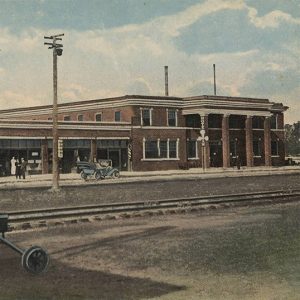 Boas Hotel
Boas Hotel 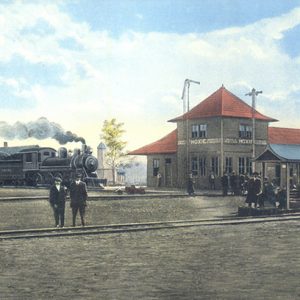 Hoxie Depot
Hoxie Depot 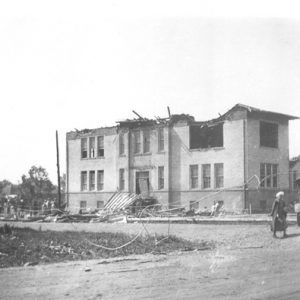 Hoxie Tornado, 1927
Hoxie Tornado, 1927 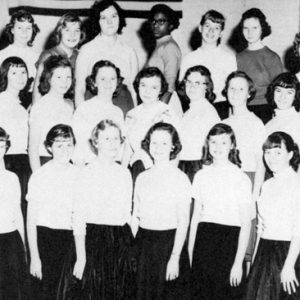 Hoxie Glee Club
Hoxie Glee Club 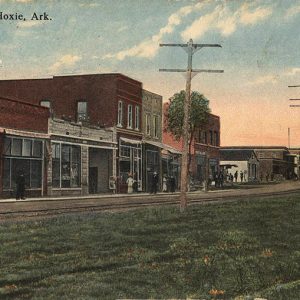 Hoxie Street Scene
Hoxie Street Scene 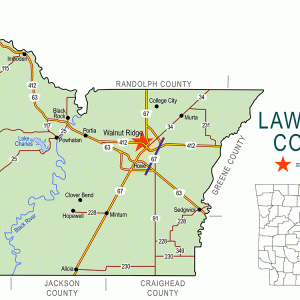 Lawrence County Map
Lawrence County Map 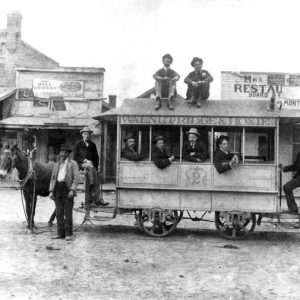 Walnut Ridge and Hoxie Mule Car Line
Walnut Ridge and Hoxie Mule Car Line 



Comments
No comments on this entry yet.